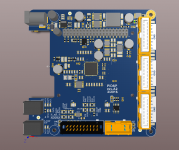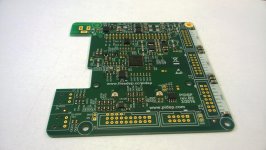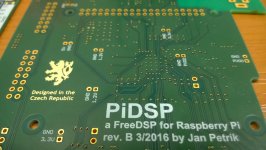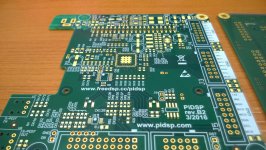It is an eclipse IDE. So why work with this one and not eclipse?
It's easier for somebody with no experience. Just for the first steps.
The problem is that you cannot use it on Linux.
Thx. I'm using Altium Designer.hey nice job !!! it looks fantastic ��
I can see a couple of u.fl surface connectors, maybe for an external master clock?.
What do you use for the design ? (eagle,etc). I find really difficult to route the ADAU1701, cannot imagine what is like to route the 1452 with so many pins
cheers
Pepe
Yes, one U.FL is for external MCLK, one is just MCLK output. It's just an alternative output of MCLK, otherwise MCLK is presented on IDC connectors on back edge.
Yes, routing kinda sux(quite few compromises ). I was tempted to switch to 6L board so many times... I stayed with 4L due to availability.
Yep, single clock, RPI res-sampling. That is where I'm going. I'll do the same for the other input(windows machine with usb soundcard) - re-sample at source.1. DSP board with one fixed clock. R-Pi connected to one of the I2S lines as a music source. The R-Pi resamples to whatever fixed frequency we've set. This is the simplest, out-of-the-box case. The Linux driver can be very simple, basically setting the R-Pi in slave mode. It might be that there is already a generic I2S driver that does this for us.
This would be probably more useful in the short run - the ability to upload firmware through RPI, and when you can talk to the DSP from Rpi, you could control volume at DSP/DAC, instead of in RPi.2. (optional but nice) Possibility to connect the DSP master control bus (now SPI?) to the controller or external EEPROM board.
Actually its i2c again, had to make some space for another wires...

Thx ojg
Btw. I've seen some really interesting webinar from Steve Sandler(of Picotest) about flat power impedance - highly recommended.
I've spent last few days in bed with a fever, I'm sorry but i can not report any progress on my part. Hopefully upcoming days will be better.
Hi everyone on this thread. I've wanted to make a start on this project for a while, and after shying away from freeDSP (not enough audio in/outs or processing speed), I discovered you guys were already head down tail up. I would love to join the group, and contribute what I can, mostly electronic design (I use Altium Designer), algorithms, most audio-related stuff, and making some headway with RPI / Linux / Python.
I want to get my head around the state of this project - lots of reading to do, but just had to say hello first.
Cheers
Tony
I want to get my head around the state of this project - lots of reading to do, but just had to say hello first.
Cheers
Tony
Welcome Tony 
The PiDSP board is in finishing phase - I've included ESD protection on gpio/adc and changed buck converter to something more powerful(LMxxxx part, current mode with external comp, 4A? dunno the part number from top of my head. ). Layout is not done yet, but I hope It's not that far off.
If you like pcb/electronics design than DAC board is in the making and it needs quite some attention. The design has been thought out quite a bit,but board needs quite some work. It might be "available"(there is a picture of it few pages back) for you to continue if DAC is what interest you. Since I've spent quite some time with it already, I could pass you some notes + design files.
Another pcb project could be the front panel pcb. The connector on the Pidsp carries 4ADC,4GPIO, i2c from rpi for LCD, one pin from RPI for remote control + power management(power button + kill signal). Control panel would make this project really sweet. It would be easier/shorter project than DAC/ADC board and this I did not think about at all(So you would start on green field, with no jabbering about how I would go about it.).
High quality ADC board could be another popular possibility.
I'm up for a chat on skype if you like .
.
The PiDSP board is in finishing phase - I've included ESD protection on gpio/adc and changed buck converter to something more powerful(LMxxxx part, current mode with external comp, 4A? dunno the part number from top of my head. ). Layout is not done yet, but I hope It's not that far off.
If you like pcb/electronics design than DAC board is in the making and it needs quite some attention. The design has been thought out quite a bit,but board needs quite some work. It might be "available"(there is a picture of it few pages back) for you to continue if DAC is what interest you. Since I've spent quite some time with it already, I could pass you some notes + design files.
Another pcb project could be the front panel pcb. The connector on the Pidsp carries 4ADC,4GPIO, i2c from rpi for LCD, one pin from RPI for remote control + power management(power button + kill signal). Control panel would make this project really sweet. It would be easier/shorter project than DAC/ADC board and this I did not think about at all(So you would start on green field, with no jabbering about how I would go about it.).
High quality ADC board could be another popular possibility.
I'm up for a chat on skype if you like
Welcome Tony
The PiDSP board is in finishing phase - I've included ESD protection on gpio/adc and changed buck converter to something more powerful(LMxxxx part, current mode with external comp, 4A? dunno the part number from top of my head. ). Layout is not done yet, but I hope It's not that far off.
If you like pcb/electronics design than DAC board is in the making and it needs quite some attention. The design has been thought out quite a bit,but board needs quite some work. It might be "available"(there is a picture of it few pages back) for you to continue if DAC is what interest you. Since I've spent quite some time with it already, I could pass you some notes + design files.
Another pcb project could be the front panel pcb. The connector on the Pidsp carries 4ADC,4GPIO, i2c from rpi for LCD, one pin from RPI for remote control + power management(power button + kill signal). Control panel would make this project really sweet. It would be easier/shorter project than DAC/ADC board and this I did not think about at all(So you would start on green field, with no jabbering about how I would go about it.).
High quality ADC board could be another popular possibility.
I'm up for a chat on skype if you like.
This is very interesting. Unfortunately, I cannot help you since I do not have enough knowledge to achieve this. However, I'm interested about buying the finished board. Do you have any plan about selling?
Pitrsek,
Is the concept for these board developments to be cutting edge sota? I was looking at the differences between the ADAU1452 and the integrated ADAU1701 which does most of what you are doing with all these discrete sections and the integration of most of these functions into the 1701 chipset. I realize you can chose dac's and adc and clocks and was just trying to catch up on the concept here. Thanks for any answers.
Is the concept for these board developments to be cutting edge sota? I was looking at the differences between the ADAU1452 and the integrated ADAU1701 which does most of what you are doing with all these discrete sections and the integration of most of these functions into the 1701 chipset. I realize you can chose dac's and adc and clocks and was just trying to catch up on the concept here. Thanks for any answers.
Hi guys,
I have received several inquires about buying the board.If you don't mind, I'd like to ask You few questions:
Would you be interested in bare PCB, or populated one?
In which version would you be more interested? In current smaller one, or the bigger one from the beginning of the thread(spdif in/out, powersupply for rpi onboard, eurocard format)?
Keep up the good work Pitrsek!
I am hoping for a completed board to use with my RPI2, I already use a IQAudio DAC and use Rune or Volumo for playback with good sound quality.
I would like to use the DSP 2.0 as a pre with volume control and need an analogue input for vinyl.
I think having an DAC on the same board makes sense, can have small signal path and low noise etc.
If an all in one RPI DSP DAC was made it could be a versatile system, allowing Pre DSP, room correction, measurement if REW was compiled on RPI? And with software like Volumo and Rune, an excellent digital Hifi.
But I can understand wanting to keep the units separate, and probably give the project a wider appeal.
I'm grateful either way!
Thanks
Ian
On the question of DAC, you do have a "competitor" here: http://www.diyaudio.com/forums/digital-line-level/286941-open-hardware-dsp-platform.html
His DAC board should in theory be possible to connect to your DSP board using a special cable harness. I think the ADAU1966 is a good choice for a multichannel DAC.
His DAC board should in theory be possible to connect to your DSP board using a special cable harness. I think the ADAU1966 is a good choice for a multichannel DAC.
I forgot to add, that it would be ideal to be able to run Sigma Studio on the RPI too, that way we could adjust on the fly and room eq all from one device.Keep up the good work Pitrsek!
I am hoping for a completed board to use with my RPI2, I already use a IQAudio DAC and use Rune or Volumo for playback with good sound quality.
I would like to use the DSP 2.0 as a pre with volume control and need an analogue input for vinyl.
I think having an DAC on the same board makes sense, can have small signal path and low noise etc.
If an all in one RPI DSP DAC was made it could be a versatile system, allowing Pre DSP, room correction, measurement if REW was compiled on RPI? And with software like Volumo and Rune, an excellent digital Hifi.
But I can understand wanting to keep the units separate, and probably give the project a wider appeal.
I'm grateful either way!
Thanks
Ian
Can the RPI be used to program the DSP instead of an usb programmer?
Cheers
Ian
Pitrsek,
Is the concept for these board developments to be cutting edge sota? I was looking at the differences between the ADAU1452 and the integrated ADAU1701 which does most of what you are doing with all these discrete sections and the integration of most of these functions into the 1701 chipset. I realize you can chose dac's and adc and clocks and was just trying to catch up on the concept here. Thanks for any answers.
Hi, it depends on your definition of cutting edge, it aims to be as good as possible, just before things get awfully complicated and expensive. It should be quite universal, without being overly complex. Clocks are onboard, but if you want, you can bring your own from external source. I hope that I will finish DAC board in same footprint, so you can plug these two boards in hammond chasis, add 12V adapter, and have a really nice xover/playback system.
@Webby
Thanx
4 analog inputs(for pots) for controlling the dsp - vol. bal. etc
4 GPIos for buttons/status leds.
1 GPIO from RPi for infrared remote
I2C from RPI fro lcd display
Power button
Unfortunatelly, ADC is not on my list right now. If anyone want to make his own board, I'll be glad to have a chat and give few tips.
In order to make ADC board compatible with FreeDSP please see:
https://github.com/freeDSP/WIKI-AND-GENERAL-TOPICS/wiki/freeDSP-Guidelines
@OJG
thx for the link, as long as your dac got standard I2S input, you can connect it to PiDSP
@Pepe
Well, i was thinking about it a lot, and I've asked for input here why i should do it...
anyway, in the end I've decided to be part of FreeDSP family and release it under same license
So yes, the project is open. It's just that since it's not done yet, I haven't posted source files.
I was more busy last month than planed and did not have much time for this project. So I decided that I need to move it forward a bit, so I took Friday off and spent better half of it in front of my computer....
Please have look at the schematics, some values are not final, and will be selected after measurement on populated PCB. If you spot something let me pls. know.
The board needs a little polishing, but it is almost done, I hope I will send it to production sometime during next week.
It turned out that I have one more GPIO from DSP free, i was thinking about beefing it up with external transistor and bringing it out on connector, so you can connect it to SSR and switch off your amplifier when you are not playing.
And it would be probably nice to have +5V on some connector too...
I hate feature creep

I spent some time with DAC too, I've decieded to make the DAC power supply quite straightforward(compared to my original plans). LM1117+TL431 for DAC, LM1117 for opams, LM1117 for 3V3. maybe something smaller if I need the PCB estate. The project is dragging for some time know and I'm getting a bit tired of it. It might happen that I take a pause before finishing the DAC - just FYI.
So, please have look at the schematics + board and let me know
Attachments
Yes, you can program DSP with RPi by using I2C write-through. Don't ask me how, I haven't done it, just know that it is possible.I forgot to add, that it would be ideal to be able to run Sigma Studio on the RPI too, that way we could adjust on the fly and room eq all from one device.
Can the RPI be used to program the DSP instead of an usb programmer?
Cheers
Ian
AFAIK, you need windows to run Sigma Studio..
Very nice work Pitrsek! I really like the clean layout with the logical grouping of components. And thank you for publishing the schematic.
Are you planning on selling fully assembled PCBs, or bare PCBs? In the latter case it would be nice if all the components could be hand soldered (by an experienced hand at least). It seems you are very close, only the LM3370 is impossible to hand-solder, would you consider using an alternative with a different package (f.ex. LM26420)?
Are you planning on selling fully assembled PCBs, or bare PCBs? In the latter case it would be nice if all the components could be hand soldered (by an experienced hand at least). It seems you are very close, only the LM3370 is impossible to hand-solder, would you consider using an alternative with a different package (f.ex. LM26420)?
Thx.
About PCBs dunno, I'd prefer selling populated boards. About packages - if you can solder ADAU1452, you can solder LM3370.You should use hot air soldering/re-flow (yes, you can do without, but it's not really good soldering and not good for the PCB either). I haven't had time(I'd rather spend it by tidying up silkscreen) to look for something similar like LM3370 in different package(this aspect did not occurred to me before you brought it up). LM26420 is way beefier animal, and way more expensive too. If you(or anyone else) suggest similar alternative to lm3370 in better package, I'll surely look into it.
About PCBs dunno, I'd prefer selling populated boards. About packages - if you can solder ADAU1452, you can solder LM3370.You should use hot air soldering/re-flow (yes, you can do without, but it's not really good soldering and not good for the PCB either). I haven't had time(I'd rather spend it by tidying up silkscreen) to look for something similar like LM3370 in different package(this aspect did not occurred to me before you brought it up). LM26420 is way beefier animal, and way more expensive too. If you(or anyone else) suggest similar alternative to lm3370 in better package, I'll surely look into it.
Hi Pitrsek,
Can you clarify how I would connect the PIDSP to the I2S DAC, I have the HAT expansion board below;
Pi-DAC+ I2S audiophile sound card for Raspberry Pi
Would they share the expansion header on the RPI2?
FYI I would prefer a populated PCB given the choice.
Many thanks
Ian
Can you clarify how I would connect the PIDSP to the I2S DAC, I have the HAT expansion board below;
Pi-DAC+ I2S audiophile sound card for Raspberry Pi
Would they share the expansion header on the RPI2?
FYI I would prefer a populated PCB given the choice.
Many thanks
Ian
Hello Ian, DSP can not share RPI header with another i2s device. I2S signal needs to go to DSP first, and then from the header on right side of the pcb to DAC. For connecting your DAC to the dsp, You'll need either to make custom cable, or use one of these:

@ojg - I'm looking into it .)
Best regards,
Jan

@ojg - I'm looking into it .)
Best regards,
Jan
Thanks Jan,
If i understand correctly, the DSP is mounted on the RPI header in the same way as my PIDAC. So I would remove the PIDAC, replace with the DSP and use its expansion header to feed the PIDAC now stand alone?
Any idea when we might see a populated PCB available, very excited about this project!
Cheers
ian
If i understand correctly, the DSP is mounted on the RPI header in the same way as my PIDAC. So I would remove the PIDAC, replace with the DSP and use its expansion header to feed the PIDAC now stand alone?
Any idea when we might see a populated PCB available, very excited about this project!
Cheers
ian
- Home
- Source & Line
- Digital Line Level
- freeDSP V2.0 (ADAU1452) developement thread



